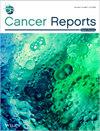Characteristics and Prognostic Markers of Aggressive Subtypes of Thyroid Cancer: A Retrospective Study
Abstract
Objective
The prevalence of thyroid cancer has increased significantly. Aggressive subtypes of papillary thyroid cancer (AG-PTC) and high-grade follicular cell-derived malignancies (HGFM) are malignancies that lie between well-differentiated and undifferentiated cancers, and their management needs to be clarified. The aim of our study is to describe the clinicopathological characteristics of AG-PTC and HGFM and to assess their prognostic value.
Methods
This was a retrospective chart review study at single center of patients with AG-PTC or HGFM. HGFM comprised of patients with poorly differentiated thyroid cancer (PDTC) and differentiated high-grade thyroid carcinoma. The clinical presentation, pathological characteristics, molecular markers, specific treatments, and clinical outcomes were compared between the groups.
Results
Of the 3244 thyroid cancer charts reviewed, 136 met the criteria for AG-PTC and HGFM. The mean age at diagnosis was 49 years, with a predominance of women. The median follow-up duration was 3 years. The rate of persistent or recurrent disease was 40.3% in the AG-PTC group and 29.3% in the HGFM group, 4.5% died in the AG-PTC group, and 1.8% died in the HGFM group. The presence of vascular, lymphovascular invasion and extrathyroidal extension were associated with a higher incidence of persistent or recurrent disease (Hazard ratio: 2.5, 3.8, and 4.2, respectively; p < 0.05). When the Ki-67 index was divided into five groups, the recurrence rate was higher in the ≥ 20% Ki-67 group.
Conclusions
Possible prognostic markers for predicting worse prognosis include vascular/lymphovascular invasion, extrathyroidal extension, and the proliferative index Ki-67.


 求助内容:
求助内容: 应助结果提醒方式:
应助结果提醒方式:


